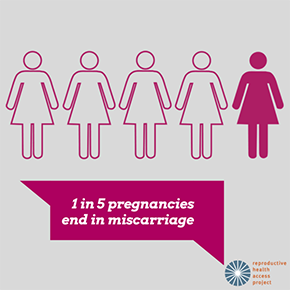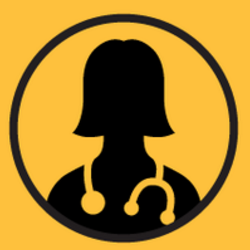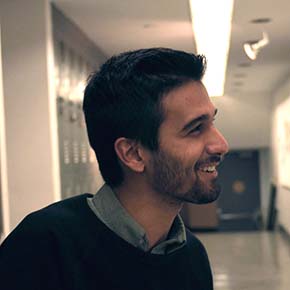Nov 06

Help Us Protect Access to Sexual and Reproductive Health Care Today!
 Did you know that one in five pregnancies ends in a miscarriage? Six percent of family physicians (and even fewer nurse practitioners and physician assistants) learn the skills to comprehensively manage early pregnancy loss—despite the fact that millions of people in the United States get their pregnancy care from primary care providers. Our Miscarriage Care Initiative gives patients a voice in their care decisions during a time when they feel decisions have been made for them. We teach clinicians to offer and provide all the options in a gentle and patient-centered way.
Did you know that one in five pregnancies ends in a miscarriage? Six percent of family physicians (and even fewer nurse practitioners and physician assistants) learn the skills to comprehensively manage early pregnancy loss—despite the fact that millions of people in the United States get their pregnancy care from primary care providers. Our Miscarriage Care Initiative gives patients a voice in their care decisions during a time when they feel decisions have been made for them. We teach clinicians to offer and provide all the options in a gentle and patient-centered way.
“Before RHAP’s Miscarriage Care Initiative, if you had a miscarriage in Butte, Montana, you were not offered all your options. In general, you were either referred to the hospital for surgery or asked to wait. Your choices depended on the culture of the institution, not on the real choices available.”– Serena Brewer, MD, Butte
Studies have shown that women who are able to select their treatment option fare better emotionally after miscarriage than those left out of the decision-making process.
Help us support other clinicians like Dr. Serena Brewer who want to provide comprehensive reproductive health care in their community.
Your gift today will help us support programs like the Miscarriage Care Initiative and make reproductive health care accessible to everyone, everywhere.
A generous donor has agreed to match all donations made before December 31st, up to $20,000! Double the impact of your gift and donate now!
 Since day one, the Reproductive Health Access Project has been getting free office space from a large community health center in New York City. This is really no small thing. Being embedded within a large, cutting-edge primary care clinic allowed us to easily keep our fingers on the pulse of community health care. The free office space also kept our overhead expenses very, very low, allowing us to allocate more funds to our various initiatives.
Since day one, the Reproductive Health Access Project has been getting free office space from a large community health center in New York City. This is really no small thing. Being embedded within a large, cutting-edge primary care clinic allowed us to easily keep our fingers on the pulse of community health care. The free office space also kept our overhead expenses very, very low, allowing us to allocate more funds to our various initiatives.
Unfortunately, the building housing the health center has been sold, and everyone moved out as of December 1st. The organization that has been hosting us for free can’t accommodate us in their new space. So, for the first time in 12 years, RHAP will have our own office space.
We found an amazing, light-filled space in New York’s garment district. RHAP supporters helped us keep expenses down. A big thanks to our amazing broker, Janet Liff, for helping us find the space. Channing Redford donated her architectural services – helping us make the most of our new office space – and the lawyers at Simpson Thatcher provided us with pro bono legal support as we negotiated our lease. It takes a village, truly.
We are still in transition to the new space, but as soon as we are fully settled we’ll be hosting an open house. Stay tuned. In the meantime, you can still reach us at our usual email and mailing address, but we now have a new phone number: 646-895-6464.
 The Family Medicine Resident:
The Family Medicine Resident:
The first time I met Joanna* was when she and her husband came into the clinic to establish prenatal care. She was 9 weeks pregnant at that time. As soon as I walked into the room, I could tell that they were both so excited, and Joanna expressed to me that she felt lucky to have become pregnant so easily. Joanna’s happiness was contagious; I immediately felt connected to her and imagined how meaningful it would be for me to be the one to deliver her baby in several months’ time. This was Joanna’s first pregnancy, and she was nervous something might go wrong because she was in her late 30s. To add to her stress, she had just found out that she was uninsured and ineligible for Medicaid. I reassured her that we would be able to work together to minimize excessive testing and limit out-of-pocket costs until she would be able to access health insurance through her employer after the new year. As part of our shared decision – making, we decided to hold off on an initial ultrasound until the more formal ultrasound at 16 weeks in order to help keep costs down. Meanwhile, all of Joanna’s other prenatal testing came back normal, and I provided her with my cell phone number to ensure she could easily reach me with any questions or concerns.
A few weeks after our first meeting, Joanna texted me that she had started spotting the night before. While it had initially resolved, she was now at work and the spotting had started up again. I had a sinking feeling and immediately worried that Joanna was having a miscarriage. I called her and we decided it would be best for her to come into clinic right away for an ultrasound. Although I couldn’t be in clinic that afternoon, I scheduled her with Dr. Prine and planned to come to clinic as soon as I could to try to see her before the end of the visit.
The Family Medicine Attending:
When I reviewed Joanna’s chart I was worried. At age 39, there is a high risk of miscarriage. Due to the cost, she hadn’t had an early ultrasound to establish that the pregnancy was what we call “viable” and now she was spotting. I entered the room where Joanna was waiting with trepidation. She looked worried and guarded, and could hardly make eye contact. I explained that I wanted to do an ultrasound to see what was going on. She was so quiet that I couldn’t tell if what I was saying was registering. I left so that she could get changed in private and returned a few minutes later. Sure enough, the ultrasound pictures showed an empty gestational sac, something that might be normal for a 6-week pregnancy, but unfortunately, she was supposed to be 10 weeks at that point. When a patient experiences an early pregnancy loss, I’m reluctant to break the news all at once because it just feels like hitting someone with a hammer. And there are other possibilities: perhaps she got pregnant a month or two later than she thought and perhaps this was just a very early pregnancy that would still develop? I removed the ultrasound probe and told her that I wasn’t seeing a 10-week pregnancy. I mentioned these other possibilities.
Joanna just didn’t respond at all, until a tear trickled down one cheek. “I’m so sorry,” I said, starting to choke up myself. “If this is a miscarriage, the one thing I want you to know is that you didn’t cause this, you didn’t do anything to make this happen. Nature just has a way of picking out pregnancies that would not develop normally and making them stop. It’s a normal process and doesn’t mean you can’t get pregnant again and have a successful birth. If it’s a miscarriage, it is not your fault.” She nodded and more tears streamed down her cheeks. I passed the box of tissues. We made a plan for blood tests (hCGs) and another ultrasound, if needed, in a week to be sure of the diagnosis.
In my experience, women tend to blame themselves when they have miscarriages. They think about that bit of rigorous exercise they did, or the wine they drank one night, or the sex they had. But we know, medically, that these things don’t cause miscarriages. As clinicians, it’s so important for us to take away that blame, normalize what they are going through, and give them the space to mourn when they are ready. I gave her my cell number, and she already had her resident’s contact info, so that she could be in touch with us if the spotting turned into bleeding and she needed additional treatment.
The Family Medicine Resident:
I made it to the clinic just as Joanna was leaving. Dr. Prine told me the ultrasound showed a pregnancy that had failed to grow appropriately and it was likely Joanna was having a miscarriage. I ran out to the lobby to find her before she left and gave her a long, tear-filled hug. I’ve felt emotionally invested in many of my patients’ stories before, but this one was particularly difficult. I felt responsible for Joanna’s loss and worried that I could have somehow provided better care to prevent this from happening. Beyond that, though, I was sad to lose the potential relationship we could have built over the next several months of her pregnancy and afterward as I cared for her and her new baby.
Joanna had decided with Dr. Prine that she wanted to do some waiting, to see if the spotting continued. She and I stayed in touch the rest of that week and through the weekend. Then, we confirmed on the following Friday that her hCG level was indeed dropping and the bleeding was continuing; the pregnancy was definitely not viable. Joanna decided to proceed with medical treatment and took misoprostol pills at home to manage her miscarriage. At that point, she wanted to move on and get ready to become pregnant again, but didn’t want a procedure if she didn’t have to have one. Of course, I was happy to support this choice of hers and reviewed what to expect when she used the misoprostol, how to treat the pain of the cramping, and when to call me if anything seemed out of hand. I had Dr. Prine’s phone number as back-up and kept my phone nearby all weekend, as I worried about what she would be going through. When Dr. Prine and I saw her in clinic on Monday, the ultrasound showed the miscarriage was complete and Joanna was starting to ask questions to plan for her next pregnancy. I was so glad to see she was ready to move on, and I was so impressed with her resilience and strength despite her sadness. I was honored when she told me she wanted me to continue to be her physician and to care for her again the next time she becomes pregnant.
Throughout this time, I was so thankful that Joanna was able to reach me so easily and come into our clinic to immediately receive our family medicine patient-centered care, rather than ending up in an emergency room, where, after a long wait, a provider she had never met before would have informed her that her pregnancy was not viable. Too often, people in this setting are given appointments for a “D&C” in the operating room, rather than choices about how to proceed with their care in more non-invasive ways. As family medicine physicians, there are very few things we do that provide such immediate gratification and have significant impact on the lives of our patients as empowering them to make their own reproductive health care choices. Every day that I am able to support a patient to make their own decisions about their bodies, to live the life they imagine for themselves – whether that means preventing, ending, or managing a pregnancy – I feel incredibly privileged to have the job that I have.
*The patient’s name has been changed for privacy.
 Mateo Nava is an artist, volunteer, and donor. His work is invested in conflating, juxtaposing, and contrasting religious and fictional narratives pertaining to the colonial history of Mexico. Like many of us, Mateo learned about the Reproductive Health Access Project through an ally. His ally just happens to be RHAP’s very own Program Associate, Natalie.
Mateo Nava is an artist, volunteer, and donor. His work is invested in conflating, juxtaposing, and contrasting religious and fictional narratives pertaining to the colonial history of Mexico. Like many of us, Mateo learned about the Reproductive Health Access Project through an ally. His ally just happens to be RHAP’s very own Program Associate, Natalie.
“Recently, people have become more vocal about their support for mainstream reproductive justice organizations. That is definitely inspiring. But at the same time, we have to be realistic and look at the numbers. If a single organization controls most abortion clinics in this country and that organization is being actively targeted by this administration, we have to build a scaffolding around reproductive care in this country. And this is precisely what RHAP does.”
Mateo tells us he had a very religious upbringing which prevented him from learning early in life about the need to protect women’s right to choose. “I owe all of my knowledge on this topic to Natalie, whose dedication to this work is a daily inspiration and always humbling. I am still learning every day.”
This past October, Mateo generously donated an art piece to auction and raise funds at RHAP’s 10th anniversary of the Reproductive Health Care and Advocacy Fellowship event. “I think it’s great that RHAP is inviting people from completely different backgrounds (such as art) to participate in the Repro movement and help through their own work in a different discipline.”
Mateo hopes to continue being a supporter through his artwork. He tells us “…mainstream reproductive justice organizations are under severe attack from politicians that neglect the need for access to abortion or even preventive care. I find that RHAP’s efforts to train abortion and thus disseminate access to abortion is helping reinforce reproductive care in this country. This, to me, is such a unique and powerful way to push against the threat of this administration. I am motivated to be involved by people with immense character, intellect, and commitment to this cause, whether it is my partner, her friends, the inspiring individuals that she tells me about, or the RHAP team.”
There are many ways to get involved with RHAP. If you have a special skill, interesting idea, or just the desire to volunteer, please check out our volunteer opportunities. If you don’t see anything there that applies to you, email us. “It’s easy to forget about certain issues; we either rule them out or remain indifferent, thinking they don’t directly affect us. Let’s be listeners, allies, and supporters.” In your unique way, you can help us expand access to abortion, contraception, and miscarriage care to those who need it most.
Your gift allows us to train and support health care providers across the United States so they can offer patients compassionate and comprehensive care.
Nov 06
